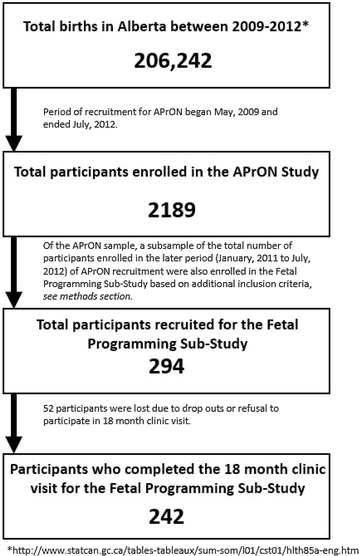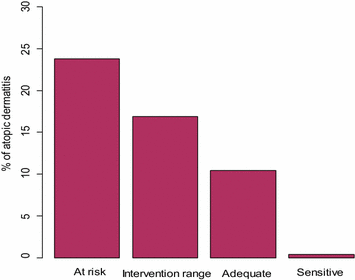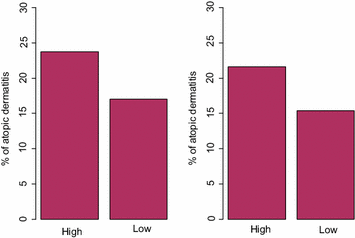Maternal sensitivity and social support protect against childhood atopic dermatitis
- PMID: 28559916
- PMCID: PMC5446757
- DOI: 10.1186/s13223-017-0199-4
Maternal sensitivity and social support protect against childhood atopic dermatitis
Abstract
Background: Many studies have identified associations between qualities of maternal-child relationships and childhood asthma, but few have examined associations with childhood atopic dermatitis (AD), a common precursor to asthma. Moreover, maternal psychological distress, including prenatal and postnatal depression, anxiety and stress, may increase risk, while social support from partners may reduce risk for childhood AD. We sought to uncover the association between maternal-infant relationship qualities (maternal sensitivity towards infant behavioral signals, controlling behavior, and unresponsiveness) and child AD after accounting for risk (i.e., prenatal and postnatal maternal depression, anxiety and stress) and protective (i.e., social support) factors.
Methods: We conducted a secondary analysis of data collected on a subsample of 242 women and their infants enrolled during pregnancy in the ongoing Alberta Pregnancy Outcomes and Nutrition cohort study. Inclusion criteria required mothers to be >16 years of age, English speaking and <22 weeks gestational age at enrollment. Data on depression, anxiety and stress in the prenatal and postnatal periods and physician diagnosis of childhood AD at 18 months were gathered via maternal report. Maternal sensitivity, unresponsiveness and controlling behaviours were assessed via videotaped observations using the Child-Adult Relationship Experimental (CARE)-Index at 6 months of infant age.
Results: Higher maternal sensitivity, or the inability of the mother to appropriately understand and respond to infant needs based on behavioral signals, predicted reduced odds of AD independent of and in combination with low prenatal and postnatal anxiety and high paternal support. After adjustment, higher maternal controlling behaviours and unresponsiveness also predicted greater odds of AD.
Conclusions: Low maternal sensitivity is a risk factor for childhood AD, independently and in combination with perinatal anxiety and low social support. Thus, interventions that improve maternal-infant relationship quality, especially sensitivity, reduce anxiety and improve social support from partners could reduce odds of childhood AD.
Keywords: Anxiety; Atopic dermatitis; Childhood; Control; Depression; Maternal–infant relationship; Responsiveness; Sensitivity; Social support; Stress.
Figures



References
LinkOut - more resources
Full Text Sources
Other Literature Sources

